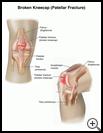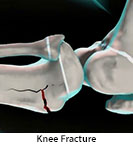
Kneecap (Patellar) Fracture
________________________________________________________________________
KEY POINTS
- A kneecap fracture is a break or crack in the kneecap.
- Treatment may medicine, physical therapy, a brace, or sometimes surgery.
- To help prevent injury, your child should wear protective equipment that fits properly when playing sports, and stretch before and after physical activity.
________________________________________________________________________
What is a kneecap fracture?
A kneecap fracture is a break or crack in the kneecap (patella). It may be just a small crack in the bone, or the bone may break into pieces or shatter. Some fractures may stick out through the skin.
A kneecap fracture is also called a patellar fracture.
What is the cause?
A broken kneecap usually results from a fall onto the knee or a direct hit to the knee. Some kneecap fractures can happen when your child is jumping or running.
What are the symptoms?
Symptoms may include:
- A snapping or popping sound at the time of the injury
- Pain, swelling, bruising, or tenderness that happens right after the injury
- Trouble walking or straightening the leg
How is it diagnosed?
Your healthcare provider will ask about your child’s symptoms and medical history and examine your child. Tests may include X-rays or other scans.
How is it treated?
The treatment depends on the type of fracture.
- If your child has an open wound with the fracture, he may need treatment to control bleeding or prevent infection.
- Your child may need surgery to:
- Remove all small fragments of bone
- Wire the kneecap fragments together, if possible
- Remove the kneecap if it has shattered
- Your child’s leg may be put in a brace, splint, knee immobilizer, or cast to keep his knee from moving while it heals. Your child should use crutches or a cane as directed by the healthcare provider.
Your child’s healthcare provider may prescribe pain medicine.
With treatment, the fracture may take 6 to 8 weeks to heal. Your child may need to do special exercises to help his leg get stronger and more flexible. Ask your child’s healthcare provider about this.
How can I take care of my child?
Follow the full course of treatment your healthcare provider prescribes.
To keep swelling down and help relieve pain:
- Put an ice pack, gel pack, or package of frozen vegetables wrapped in a cloth on the injured area every 3 to 4 hours for up to 20 minutes at a time for 3 days after the injury.
- When your child sits or lies down, he should keep the injured leg up on pillows so that it is above the level of the heart. Keep the knee straight.
- Give your child pain medicine as directed by your healthcare provider.
Ask your healthcare provider:
- How and when you will get your child’s test results
- How long it will take to recover
- What activities your child should avoid and when he can return to normal activities
- How to take care of your child at home
- What symptoms or problems you should watch for and what to do if your child has them
Make sure you know when your child should come back for a checkup. Keep all appointments for provider visits or tests.
How can I help prevent a kneecap fracture?
Most broken kneecaps are caused by accidents that are not easy to prevent. However, to help prevent injury, make sure that your child:
- Wears shoes that fit well and give good support.
- Gently stretches before and after physical activity.
- Wears protective equipment that fits properly if he plays sports.
Last modified: 2017-06-26
Last reviewed: 2017-06-26


